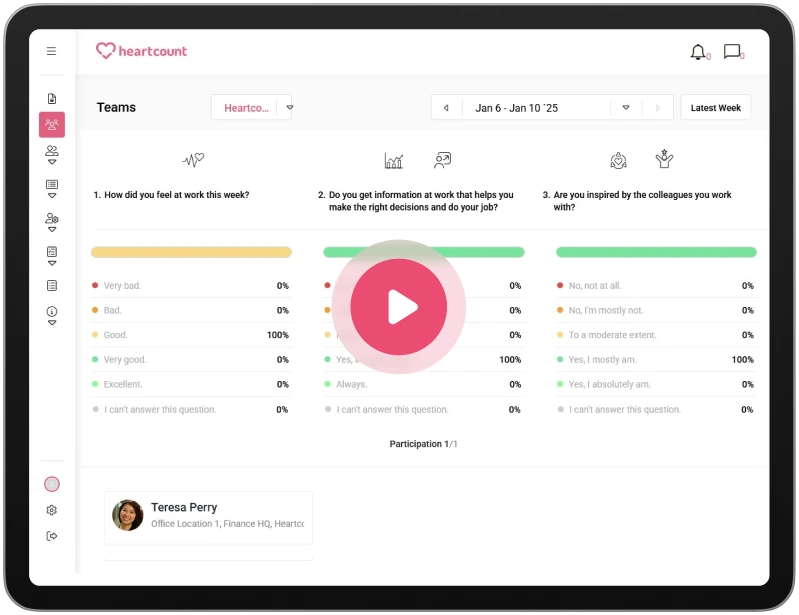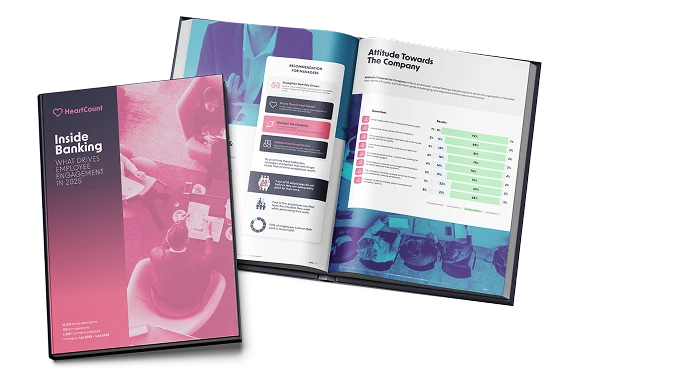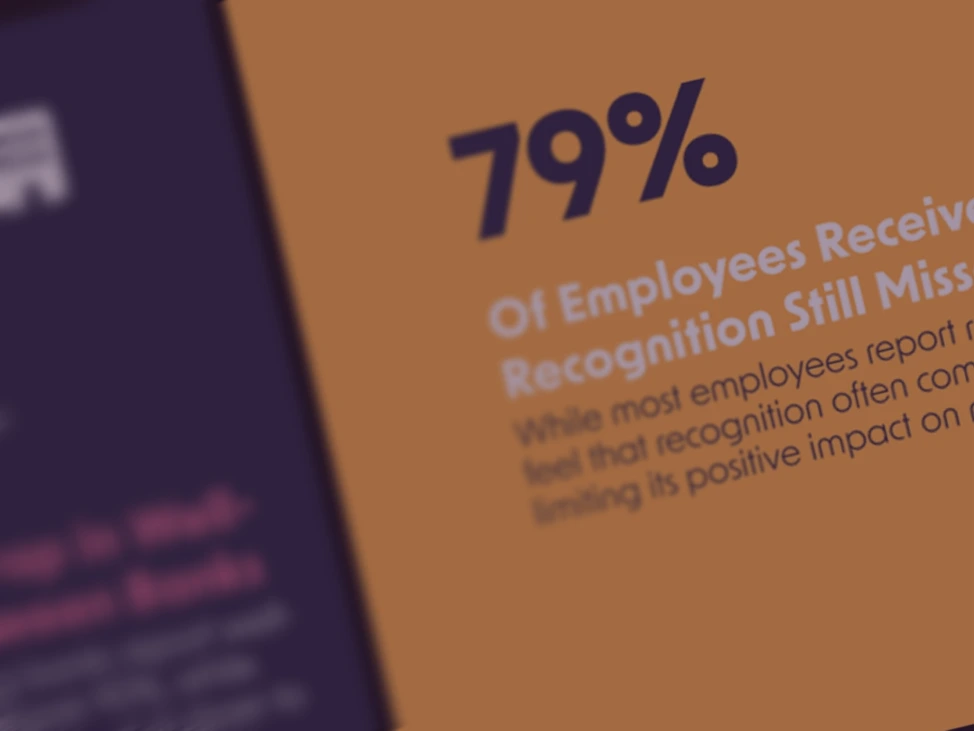Why Employees Quit: 15 Data-Backed Reasons—and How to Keep Your Best People

In 2024, the global average employee attrition rate rose to its highest level in over a decade. Surveys show that a significant share of employees are considering leaving their current job within the next few months—a trend that shows no signs of slowing. The reasons run deeper than salary: culture, leadership, purpose, and flexibility all weigh heavily on whether someone stays or walks.
Understanding why employees quit is no longer a nice-to-know—it’s a strategic imperative. High turnover doesn’t just disrupt team dynamics or inflate hiring costs. It signals cracks in the employee experience that, if left unaddressed, can erode productivity, morale, and long-term growth. Companies that prioritise real-time feedback, transparency, and people-first tools, like those offered by HeartCount, are better equipped to respond before employees disengage.
This guide breaks down 15 data-backed reasons why people leave their jobs in 2025, and what HR leaders, founders, and people managers can do today to keep their best people engaged, recognised, and supported.
In 2024, the global average employee attrition rate rose to its highest level in over a decade. Surveys show that a significant share of employees are considering leaving their current job within the next few months—a trend that shows no signs of slowing. The reasons run deeper than salary: culture, leadership, purpose, and flexibility all weigh heavily on whether someone stays or walks.
Understanding why employees quit is no longer a nice-to-know—it’s a strategic imperative. High turnover doesn’t just disrupt team dynamics or inflate hiring costs. It signals cracks in the employee experience that, if left unaddressed, can erode productivity, morale, and long-term growth. Companies that prioritise real-time feedback, transparency, and people-first tools, like those offered by HeartCount, are better equipped to respond before employees disengage.
This guide breaks down 15 data-backed reasons why people leave their jobs in 2025, and what HR leaders, founders, and people managers can do today to keep their best people engaged, recognised, and supported.
Why It Hurts When Good Employees Leave
When a high-performing employee walks out the door, it’s rarely just a one-person problem. Voluntary turnover disrupts team momentum, burdens remaining colleagues, and chips away at long-term engagement. In a time when retention is tied directly to culture, experience, and trust, understanding the real impact of losing good people is more critical than ever. As explored in this guide on employee engagement and retention, preventing turnover requires more than exit interviews—it demands real-time insight and intentional action. Before diving into why employees quit, let’s explore the true cost of their departure—and how often the signs are missed.
The True Cost of Voluntary Turnover
Losing a high-performing team member doesn’t just leave a gap, it creates a ripple effect that touches morale, productivity, customer relationships, and even revenue. According to Gallup, the cost of replacing an employee can range from half to twice their annual salary, depending on role and industry. That figure includes recruitment, onboarding, training, lost productivity, and cultural disruption.
But there’s a hidden cost as well: loss of trust. When good employees leave—especially without much notice—it signals to others that something might be wrong beneath the surface. If the exit feels avoidable, it can lead to disengagement among remaining team members, triggering even more turnover. Building a culture of trust, transparency, and proactive communication is one of the most effective ways to drive employee engagement and prevent these ripple effects.
Some of the most costly consequences of voluntary attrition include:
- Delays in project delivery
- Increased workload on already stressed teams
- Loss of institutional knowledge
- Potential hits to employer brand if the departure becomes public or viral on platforms like Glassdoor or LinkedIn
Understanding why employees quit, and recognising it early, can mean the difference between a one-off departure and a dangerous turnover trend.
Early Warning Signs You Might Miss (Pulse-Survey Data)
The warning signs of disengagement are often subtle, especially if your organisation lacks real-time visibility into employee sentiment. Missed check-ins, reduced participation, lower energy in meetings, or decreased feedback engagement may all be signs that someone’s already mentally halfway out the door.
This is where automated employee pulse check surveys come into play. Tools like HeartCount’s pulse surveys give HR teams and managers weekly, data-driven insights into how individuals and teams are really feeling—before those emotions translate into exits.
By tracking shifts in:
- Mood and stress levels
- Recognition feedback
- Perceived workload
- Trust in leadership
…you can begin spotting retention red flags weeks or months before an official resignation letter hits your inbox.
For even more insights, this HeartCount blog post on employee burnout breaks down how stress can silently erode your best people’s motivation over time.
2025 Snapshot: Why People Quit Their Jobs
In today’s workplace, retention is no longer just about perks or pay. It’s about alignment—between values, expectations, leadership, and flexibility. As companies navigate remote work models, generational shifts, and post-pandemic cultural resets, the reasons people give for quitting their jobs are evolving fast. What used to be considered “job hopping” is now often a strategic exit in search of growth, balance, or belonging.
And while turnover can be costly, it’s also predictable—if you pay attention to the data.
Fresh Stats from Gallup, LinkedIn & HeartCount Benchmarks
According to Gallup’s State of the Global Workplace Report (2024), 59% of employees are quietly disengaged, and 18% are actively disengaged—meaning they’re already mentally checking out. The result? Global productivity losses are estimated at $8.9 trillion annually.
LinkedIn’s 2024 Workplace Learning Report also highlights that:
- 94% of employees say they would stay longer at a company that invests in their learning and development
- The top three reasons professionals changed jobs last year were career growth, work-life balance, and compensation
HeartCount’s internal benchmarking data echoes these findings. Trends across thousands of pulse survey responses show that dips in:
- Recognition
- Communication from leadership
- Psychological safety
…often correlate with resignations within the next 30–60 days.
The message is clear: knowing why people quit their jobs in 2025 is not guesswork—it’s data-backed and visible in real time if you know where to look.
Generational Trends: Why Gen Z Is Quitting Faster
Gen Z—often defined as those born between 1997 and 2012—is emerging as one of the most mobile and values-driven generations in the workforce. A 2024 Deloitte survey found that 49% of Gen Z workers plan to leave their job within two years, and their top concerns are:
- Lack of purpose or societal impact
- Toxic or outdated workplace culture
- Limited flexibility (especially around remote work)
For Gen Z, quitting isn’t failure—it’s alignment. They’re more willing to walk away from a paycheck if the experience doesn’t match their expectations for growth, authenticity, or wellbeing.
To keep younger talent engaged, companies must shift from command-and-control models to cultures built on transparency, real-time feedback, and flexibility—all themes explored in this article on workplace transparency.
COLLECT
15 Common Reasons Employees Resign—Plus Prevention Tactics
While no two resignations are exactly alike, patterns emerge when you zoom out. From stalled growth to micromanagement or misaligned values, the underlying reasons people walk away from jobs are often preventable—with the right data, leadership mindset, and employee experience strategy.
Below are 15 of the most common reasons why employees quit—paired with tactical, research-backed ways to turn things around.
1. Limited Career Growth & Recognition
Employees who don’t see a future within the company eventually find it elsewhere. Lack of visible career paths, development opportunities, or recognition contributes to disengagement—especially among ambitious high performers.
How to Fix It: Visible Paths, Skill Budgets, Continuous Feedback
- Introduce role progression maps and discuss them during one-on-ones
- Set aside learning budgets and promote stretch projects
- Use automated pulse check-ins and real-time feedback tools to surface accomplishments
- Celebrate wins with a formal employee recognition system
2. Compensation & Benefits Gaps
Pay doesn’t need to be the highest in the market—but it must feel fair, timely, and connected to performance and loyalty. When compensation lags or lacks transparency, employees start looking elsewhere.
How to Fix It: Pay Transparency, Total-Rewards Story, Market Audits
- Conduct regular market comparisons and adjust salaries accordingly
- Share the full picture of your total rewards: perks, wellness, L&D, flexibility
- Train managers to have open comp conversations without defensiveness
3. Poor Leadership or Management Style
According to Gallup, managers account for at least 70% of variance in employee engagement. Micromanagement, inconsistent communication, and lack of empathy drive people out faster than almost anything else.
How to Fix It: Coaching, 360-Degree Feedback, Manager Pulse Scores
- Provide leadership coaching and peer learning for managers
- Use 360° feedback to create self-awareness and accountability
- Track trends in manager performance via employee pulse tools
4. Burnout and Work-Life Imbalance
Excessive workloads, always-on expectations, and emotional exhaustion are key factors in why good employees leave—especially if support systems are absent.
How to Fix It: Workload Signals, Well-Being Days, Boundaries Policy
- Monitor workload levels with pulse survey questions
- Encourage “no meeting” blocks and proactive time off
- Revisit your well-being policies
5. Culture & Values Misalignment
When employees feel disconnected from the company’s core mission or experience hypocrisy between values and behaviour, trust breaks down.
How to Fix It: Re-articulate Core Values, Rituals, Culture Health Checks
- Refresh your values in collaboration with employees
- Design rituals and stories that reinforce culture in action
- Use anonymous surveys to check whether values feel real—or just words
6. Lack of Meaningful Challenge
When roles become repetitive or feel disconnected from larger goals, motivation declines. Employees want to grow—not just in title, but in complexity, creativity, and purpose. A strong employee experience management system can help identify when roles are stagnating and surface opportunities for reinvention before disengagement sets in.
How to Fix It: Job Crafting, Stretch Projects, Innovation Sprints
- Encourage managers to co-design roles with their team members
- Assign innovation sprints or exploratory projects outside usual scopes
- Use feedback tools to ask: “When did you last feel proud of your work?”
7. Inflexible Work Environment
Rigid schedules, mandatory in-office policies, and lack of autonomy are major reasons why people quit their jobs in the post-pandemic era. Flexibility is no longer a perk—it’s a baseline expectation.
How to Fix It: Hybrid Guidelines, Async Collaboration, Autonomy Metrics
- Create clear policies around hybrid work, not just vague “flexibility”
- Empower teams to work asynchronously with the right tools and trust
- Measure and improve autonomy using pulse surveys and qualitative feedback
8. Low Psychological Safety & Trust
If people feel like they can’t speak up, fail safely, or raise concerns without fear of backlash, they disengage—or exit. This is especially true for underrepresented or newer team members.
How to Fix It: Anonymous Feedback, Inclusive Meetings, Mistake-Friendly Norms
- Build anonymous reporting channels and act on feedback quickly
- Train managers to create inclusive, nonjudgmental meeting spaces
- Reward learning from failure as a cultural norm
9. Insufficient Feedback & Communication
Silence is one of the most common drivers behind voluntary exits. Employees who feel unheard, unseen, or unsure of where they stand will eventually stop asking—and start applying elsewhere.
How to Fix It: Weekly Check-Ins, Real-Time Praise, Manager Nudges
- Set the expectation that every manager runs weekly one-on-ones
- Build a culture where feedback flows in both directions—up, down, and sideways
- Incorporate ongoing feedback loops that help managers surface blockers and offer recognition in real time
10. Company Instability or Ethical Concerns
Layoff rumours, inconsistent strategy, or ethical missteps break trust. People want stability and transparency—and when that’s missing, even loyal employees may feel it’s time to go.
How to Fix It: Transparent Updates, ESG Commitment, Crisis-Comms Playbook
- Regularly update your team with context, not just headlines
- Clearly communicate your ethical standards and social impact goals
- Equip leaders with talking points and guidance for tough conversations
11. Remote/Hybrid Mismanagement
Poorly implemented hybrid models—like unclear expectations, inequity between remote and in-office workers, or tech friction—often leave employees frustrated and isolated.
How to Fix It: Virtual Team Rituals, Outcome-Based KPIs, Pulse Temperature
- Design regular team rituals that include everyone, not just office-based staff
- Shift performance reviews toward outcome-based metrics, not face time
- Monitor team sentiment through consistent pulse surveys that reveal remote inclusion issues
12. Toxic Relationships or Bullying
Workplace relationships can be a source of connection—or conflict. Toxicity, cliques, or unchecked bullying are major reasons why good employees leave first, especially when they feel HR won’t intervene.
How to Fix It: Zero-Tolerance Policy, Rapid ER Escalation, Safe-Speak Channels
- Enforce and communicate a zero-tolerance policy for harassment or exclusion
- Set up safe, anonymous channels for reporting toxic behaviour
- Train managers and ER teams on rapid intervention and emotional intelligence
13. Micromanagement & Low Autonomy
When every task feels scrutinised and decisions need approval at every level, employees lose motivation. Autonomy is one of the strongest predictors of retention.
How to Fix It: Delegation Training, OKRs, Autonomy Pulse Items
- Coach managers to focus on outcomes over processes
- Use OKRs (Objectives & Key Results) to clarify priorities without hand-holding
- Include autonomy-related questions in employee satisfaction surveys to spot micromanagement trends
14. Major Personal-Life Changes
Sometimes it’s not the job—it’s life. Caregiving responsibilities, illness, a partner’s relocation, or personal transformation can all affect an employee’s decision to resign.
How to Fix It: Flex Leave, Remote Relocation Options, Alumni Pathways
- Offer temporary reduced hours or “life leave” options during transitions
- Be open to location-agnostic roles where possible
- Create a positive offboarding process that welcomes potential returners
15. Relocation or Commute Challenges
Rising commute costs, transportation issues, or moving away from HQ can prompt resignations—especially when remote alternatives are available elsewhere.
How to Fix It: Remote First Mindset, Travel Stipends, Hub-and-Spoke Offices
- Embrace a “remote-first” approach, even for hybrid teams
- Offer travel stipends or schedule flexibility for in-office days
- Consider smaller satellite offices or co-working access in key locations
How to Predict Turnover Before It Happens
Knowing why employees quit is only half the equation—predicting when it’s about to happen is what sets proactive companies apart. The good news? Most exits don’t come out of nowhere. Research from Harvard Business Review highlights that tracking subtle changes—like decreased participation, lower recognition rates, or performance dips—can accurately signal who might leave before they do. You just need the right systems in place to detect these early warning signs.
Weekly Pulse Surveys & Risk Scoring with HeartCount
Traditional annual engagement surveys are too slow and too broad to capture real-time sentiment. By the time you notice disengagement in the rearview mirror, your best people may already be gone.
This is where platforms like HeartCount change the game. Through lightweight, weekly pulse surveys, you can monitor shifts in employee mood, workload perception, recognition levels, and trust in leadership. When aggregated, this data can be used to assign risk scores—helping you flag flight risks before resignation letters arrive.
High-risk indicators often include:
- A steady drop in positivity or energy ratings
- Lower frequency of optional feedback or comments
- Decline in peer recognition or engagement with praise
- Sudden silence from employees who were previously vocal
Once these signals are visible, the next step is action.
Action Loop: Listen → Diagnose → Act → Follow-Up
Predicting turnover is only useful if you’re ready to respond. That means building an action loop into your employee experience strategy:
- Listen through short-form, consistent surveys
- Diagnose patterns (e.g. manager-specific issues, overwork, lack of recognition)
- Act on insights with targeted interventions
- Follow up to confirm improvements or iterate further
A well-timed 1:1, a change in project scope, or a recognition push can make all the difference when someone’s teetering on the edge of leaving. Pulse-based insights are the modern manager’s best retention tool.
Building a Retention-First Culture
Reducing turnover isn’t just about fixing pain points—it’s about proactively creating an environment where employees want to stay, grow, and thrive. A retention-first culture is intentional, human-centric, and continuously evolving. It aligns day-to-day experience with long-term aspirations.
Align Growth, Recognition & Rewards
Employees stay where they feel seen and supported. That requires more than one-off bonuses or annual performance reviews—it’s about integrating development and appreciation into the rhythm of work.
- Set clear growth plans and revisit them quarterly
- Create peer recognition rituals that don’t rely solely on manager input
- Use tools like HeartCount’s recognition feature to ensure wins are visible and celebrated across the org
Coach Leaders to Inspire—Not Control
Retention lives or dies at the team level. Great leadership turns average jobs into meaningful careers. But that only happens when managers lead with trust, not authority.
- Train managers in coaching skills, not just project oversight
- Include leadership effectiveness metrics in engagement pulse surveys
- Share real-time feedback that helps leaders grow in sync with their teams
Design Well-Being and Flexibility into Policy
Work-life balance can’t be left to chance—it has to be designed. Employees want policies that reflect their needs today, not outdated norms.
- Introduce well-being days, asynchronous work blocks, and microbreaks
- Craft flexible policies based on team input and regular satisfaction surveys
- Normalize breaks and boundaries by modelling them from the top
Close the Feedback Loop Using HeartCount Insights
Collecting feedback is important. Acting on it is everything. Companies that close the loop—acknowledging what they’ve heard and following up with clear actions—earn trust and reduce churn.
- Use weekly sentiment data to identify emerging friction points
- Share “you said, we did” updates across teams
- Integrate feedback channels into day-to-day tools for higher response rates
Retention starts with listening, but it’s sustained by follow-through. When employees see consistent action, they stop wondering if they matter—and start focusing on doing their best work.
UNDERSTAND
FAQ: Why Employees Quit
Why are your employees leaving?
Employees leave for a combination of reasons—ranging from lack of growth opportunities and poor management to burnout, misaligned values, or better offers elsewhere. By using tools like pulse surveys and feedback systems, organisations can uncover the real reasons behind exits and take proactive steps to improve retention.
What are the main reasons for leaving a job?
The most common reasons people leave jobs include limited career progression, inadequate compensation, burnout, poor leadership, and lack of flexibility. According to Gallup and LinkedIn reports, people are increasingly prioritising purpose, well-being, and autonomy over traditional perks.
Why are Gen Z quitting their jobs?
Gen Z employees are more values-driven and mobility-focused than previous generations. They tend to leave jobs that lack purpose, flexibility, inclusive leadership, or alignment with their personal goals. Investing in culture, recognition, and transparency is key to keeping Gen Z engaged.
Why do good employees leave first?
High performers often leave when they feel undervalued, unchallenged, or ignored. Because they tend to have more options, they’re quicker to act when something feels off—making them more vulnerable to turnover if feedback and recognition are lacking.
How can real-time feedback reduce turnover?
Real-time feedback helps surface issues before they escalate into resignations. It creates a culture of continuous improvement, recognition, and trust—three pillars that reduce disengagement and improve retention. Using tools like HeartCount’s pulse check surveys can help HR teams track trends and intervene early.









